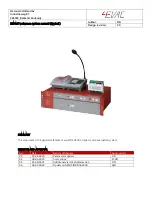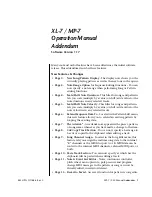
EATON
Airflex DPA Caliper Brake Installation, operation and maintenance manual
E-CLCL-II010-E
October 2015
5
1.0 Introduction
Throughout this manual there are a number of
HAZARD WARNINGS that must be read and
adhered to in order to prevent possible personal
injury and/or damage to the equipment. Three signal
words "DANGER", "WARNING", and "CAUTION" are
used to indicate the severity of the hazard, and are
preceded by the safety alert symbol .
Danger
Denotes the most serious injury hazard, and is used
when serious injury or death will result from misuse
or failure to follow specific instructions.
Warning
Used when serious injury or death may result from
misuse or failure to follow specific instructions.
Caution
Used when injury or product / equipment damage
may result from misuse or failure to follow
specific instructions.
It is the responsibility and the duty of all personnel
involved in the installation, operation and
maintenance of the equipment on which this device
is used to fully understand the
Danger,
Warning,
and,
Caution
procedures by which hazards are to be avoided.
1.1 Description
Throughout this manual, explanations mentioning
specific components of the caliper brakes are often
followed by numbers in parentheses, which refer to
the item numbers on Figure 1 Friction shoe
assembly (5).
1.1.1 Eaton Airflex 200DPA caliper brakes are ideally
suited for many high torque, high energy stopping
applications. By properly choosing actuating pressure,
number of calipers per disc,number of discs and disc
diameter, a braking system can be custom designed
for a wide variety of applications.
1.1.2 These models are opposed-piston, direct-acting,
disc-style brakes, activated by hydraulic or pneumatic
pressure. The braking torque is directly proportional
to the applied pressure.
1.1.3 The symmetrical split housing construction makes
it possible to accommodate brake discs of different
thicknesses. Friction shoes attach to the cylinders
and are replaceable without disturbing the caliper
mounting. Applying pressure to the cylinders
piston causes the friction shoes to clamp the disc,
developing the braking torque.
1.1.4 The brake design includes guide pins, which transmit
the tangential braking force from the brake pads to
the brake housings. Therefore the brake piston is not
subjected to radial force extending brake life.
1.1.5 Retracting springs, help retract the brake pads from
the disc, while brake pad wear is automatically
accommodated by an increase of the piston stroke.
1.1.6 These calipers can be air or hydraulic actuated.
Seals are compatible for either actuating media.If
hydraulic actuation is to be used, use mineral
base hydraulic fluid.
1.1.7 All Airflex 200DP caliper brakes are supplied with
long wearing, NON-ASBESTOS friction material.
1.1.8 This manual includes English measurement system
values with metric equivalents usually shown in
parentheses (XX). Please be sure to use the
correct value.
1.2
How it works
1.2.1 Air or hydraulic pressure is introduced into both
the cylinder blocks (1) via the input fitting (9).Both
pistons (2) move simultaneously and squeeze the
piston-mounted friction shoe assemblies (FSA) (5)
against the disc, causing a braking action. When the
actuation pressure is released to '0' psi (bar), the
return springs (6) retract the friction shoes from
the disc.
Airflex DPA Caliper Brake






























